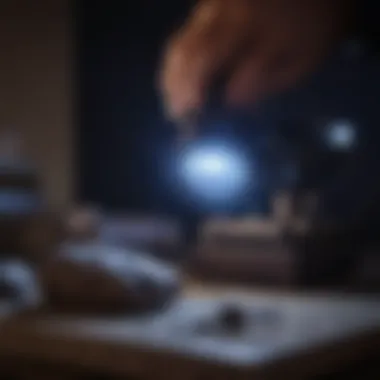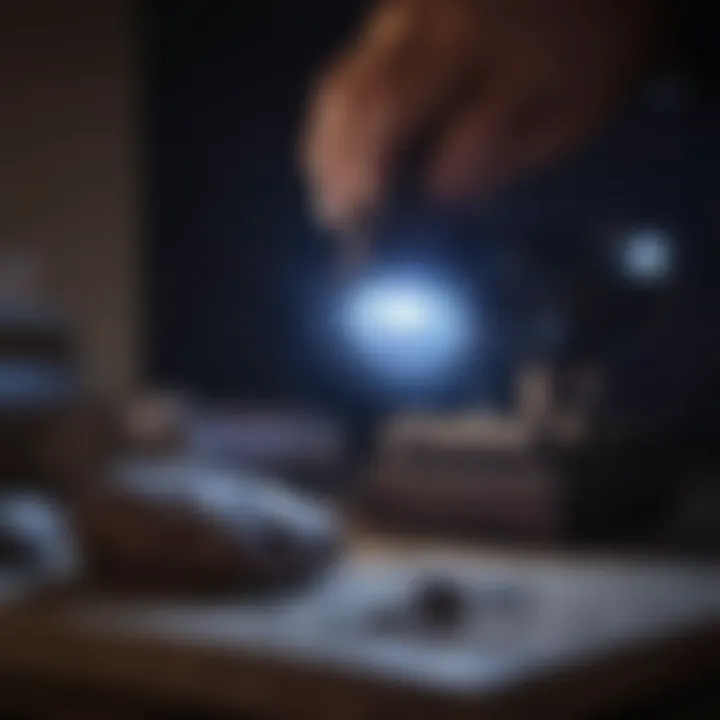Understanding UV Flashlight Bulbs: Uses and Benefits


Intro
When it comes to the world of specialized lighting, UV flashlight bulbs stand out as a fascinating technology wielding applications that are as diverse as they are critical. Often overlooked by the casual observer, these bulbs provide more than just illumination; they unlock a spectrum of possibilities in various fields. From pest control that aids in safeguarding homes against unwanted visitors, to forensic analysis that helps crack cases, and even mineralogy where enthusiasts admire the hidden colors of stones, understanding the nuances of UV bulbs becomes paramount.
As the need for niche applications continues to rise, a thorough grasp of how UV flashlight bulbs function, their types, as well as their appropriate use and safety precautions, is essential. This exploration ensures both enthusiasts and professionals alike can make informed decisions about integrating this technology into their arsenals. Let's delve deeper into this illuminating subject and explore the key aspects that will guide us through the extraordinary potential of UV flashlight bulbs.
Foreword to UV Flashlight Bulbs
The introduction of UV flashlight bulbs presents a beacon of innovation, particularly in niche fields such as pest control, forensic analysis, and mineralogy. The importance of this topic is not just derived from its technological nature but also from its applications that enhance our understanding of both the natural and artificial worlds. By delving into the functionalities and utility of UV flashlights, the reader can appreciate their practical significance and make informed choices regarding their use in various contexts.
In the field of pest control, for instance, UV flashlights can attract insects, providing an effective way to monitor and manage pest populations without resorting to harsh chemicals. For forensic analysis, they unveil evidence not visible to the naked eye, proving invaluable in criminal investigations. Likewise, mineralogy enthusiasts utilize UV light to bring out the hidden colors and luminescence of specimens, transforming the way collectors interact with their finds.
To provide a comprehensive understanding, this article will explore the definition of ultraviolet light and its historical relevance, establishing a strong foundation for a deeper discussion on the types of UV flashlight bulbs in subsequent sections.
Defining Ultraviolet Light
Ultraviolet (UV) light is a form of electromagnetic radiation with wavelengths shorter than visible light but longer than X-rays. It ranges from about 10 nm to 400 nm on the electromagnetic spectrum. This classification places UV light neatly into three categories: UV-A, UV-B, and UV-C, each with distinct properties and effects.
- UV-A: This type, with wavelengths from 320 to 400 nm, is the least energetic but the most prevalent type of UV radiation that reaches the Earth. It’s the primary builder of the natural tan, but it can also lead to skin aging and some forms of skin cancer.
- UV-B: With wavelengths ranging from 280 to 320 nm, UV-B is less common but more biologically potent. It is responsible for causing sunburns and plays a crucial role in the synthesis of vitamin D in the skin.
- UV-C: This range, from 100 to 280 nm, has the highest energy levels but is mostly absorbed by the ozone layer. UV-C is often utilized in germicidal applications due to its ability to kill bacteria and viruses.
Understanding these distinctions is key for anyone considering UV flashlight bulbs, particularly in determining their applications and safety measures.
Historical Context
The journey of ultraviolet light spans decades, beginning with its early discovery in the 1800s. In 1801, the German chemist Johann Wilhelm Ritter observed the effect of UV light when he noticed that silver chloride darkened when exposed to sunlight beyond the violet end of the spectrum. This marked the beginning of an era that would see UV light being harnessed for various practical applications.
By the late 19th century, UV light began playing a role in disinfection, with its germicidal properties being recognized. The introduction of UV lamps in the early 20th century opened new doors in medical and scientific communities, pushing boundaries in areas like sterilization and biological research.
Moreover, the 1950s and 1960s marked a significant leap forward with the synthesis of fluorescent and later, LED UV bulbs. This technological evolution not only enhanced efficiency but also democratized access to UV tools for various application fields, right down to the enthusiastic rock and fossil collectors who today rely on these tools to reveal the hidden beauty of their specimens.
Thus, the historical context of UV flashlight bulbs is not just an account of scientific progress, but also a testament to how curiosity in the natural world can lead to advancements that enhance our practical interactions with it.
Components of UV Flashlight Bulbs
Understanding the components of UV flashlight bulbs is crucial to grasping how these devices function, their various applications, and the differences among them. Each element contributes to the bulb’s efficiency, durability, and output quality. Let’s break down the two main categories: types of bulbs and construction materials, each providing unique benefits and considerations that enhance the overall effectiveness of UV flashlights.
Types of Bulbs
Incandescent UV Bulbs
Incandescent UV bulbs are the traditional choice, well-known for their simplicity and effectiveness. One of the main characteistics of these bulbs is their ability to produce UV light through a heated filament. This process creates a warm light that some collectors appreciate during specific applications. However, it's worth mentioning that the efficiency of these bulbs is not as high compared to modern alternatives.
Key Features:
- Warm light quality
- Simplicity of use
Advantages:
- Widely available
- Cost-effective option
Disadvantages:
- Limited lifespan
- Higher energy consumption
Fluorescent UV Bulbs
Fluorescent UV bulbs have gained popularity, particularly in specialized settings like forensic analysis and mineral identification. These bulbs utilize mercury vapor, which gets energized and emits UV light efficiently. Their striking feature is the ability to produce a strong output without the high heat found in incandescent models. This makes them a favorite among professionals who require reliability and intense UV lighting.
Key Features:
- Excellent brightness
- Moderate energy usage
Advantages:
- Longer lifespan compared to incandescent bulbs
- Better efficiency for specific applications
Disadvantages:
- More expensive initially
- Mercury content requires careful handling
LED UV Bulbs
LED UV bulbs stand at the forefront of technology, blending energy efficiency with long-lasting performance. Their key characteristic is the compactness of the bulb, which facilitates portability — a crucial factor for rock and fossil collectors on the go. The unique feature of these bulbs lies in their instant switch-on capability and minimal heat emission, making them both effective and safe for prolonged use.
Key Features:
- High energy efficiency
- Instant light output
Advantages:
- Long lifespan of 20,000+ hours
- Environmentally friendly with lower energy use


Disadvantages:
- Initial cost can be higher
- Certain UV wavelengths may not be produced effectively
Construction Materials
Glass Tubing
Glass tubing forms the body of many UV bulbs and plays a critical role in controlling the light emitted. The glass mustn't only be durable but also able to allow UV rays to pass through efficiently. The key characteristic here is the type of glass used, which can differ significantly in quality. Generally, borosilicate glass is often preferred for its ability to withstand high temperatures and resist shattering.
Advantages:
- Able to sustain high UV intensities
- Resistant to thermal shock
Disadvantages:
- Heavier than plastics
- Fragile if dropped
Coatings and Filters
Coatings and filters are essential for optimizing the UV light produced by the bulbs. They can enhance specific wavelengths or reduce harmful emissions, aiding in safety and effectiveness. A key aspect of coatings is their composition; materials like quartz or specialized plastics can filter out unwanted light while preserving the beneficial UV spectrum. This choice greatly impacts applications in mining and forensic investigation.
Advantages:
- Improved safety by filtering harmful UV rays
- Enhanced efficiency based on application needs
Disadvantages:
- May require replacement over time
- Cost can add up for quality filters
Electrical Components
The electrical components of UV flashlight bulbs facilitate their operation, affecting performance and efficiency. Notably, the driver circuits and connections are imperative for delivering the right amount of power. A significant characteristic is how these components can influence the lifespan and heat generation of a bulb.
Advantages:
- Proper management of power increases lifespan
- Can be designed for varying intensity levels
Disadvantages:
- Complexity can lead to failures if not properly managed
- Requires more technical knowledge for repairs
The choice of bulbs and materials is thus not just a matter of preference; it's intertwined with the specific uses and desired outcomes of collectors and other users. Each component brings distinct attributes worth considering, ensuring that enthusiasts have the right tools for their pursuits.
Operational Mechanism
The operational mechanism of UV flashlight bulbs is pivotal to their overall effectiveness and utility. Understanding the intricacies of how these bulbs function helps in appreciating their applications—ranging from scientific to everyday uses. Grasping this topic provides insight into not just the technology itself but also the quality of results they yield in various situations.
How UV Light is Generated
UV light generation primarily revolves around the excitation of atoms or molecules within the bulbs. In UV flashlights, an electric current passes through a gas-filled chamber or semiconductors, creating energy. This process is often completed by a special coating inside the bulb that serves to optimize UV emissions.
For instance, fluorescent UV bulbs utilize mercury vapor; when excited, this vapor emits UV light, which then interacts with the phosphor coating within the bulb. As the phosphor excites, it converts some of the UV light into visible light, but a substantial portion remains in the UV spectrum, specifically valuable for various applications. The efficiency of this process significantly influences the bulb’s overall performance and, consequently, its effectiveness in practical applications.
Spectrum of UV Light
The UV spectrum can’mainly be divided into three primary categories: UV-A, UV-B, and UV-C.
UV-A
One of the most prominent characteristics of UV-A is its long wavelength, typically ranging from 320 to 400 nanometers. This broad spectrum allows UV-A to penetrate deeply into the skin, making it a popular choice for various applications like tanning and certain types of forensic work. In mineralogy, UV-A light reveals vibrant colors in specific fluorescent minerals, aiding collectors in identifying valuable specimens.
The unique feature of UV-A is its ability to elicit fluorescence without causing significant damage to living tissues compared to its counterparts. It is beneficial in areas where prolonged exposure is necessary but should still be approached cautiously. Therefore, although UV-A serves an important role, awareness of its effects on skin and eyes—especially during extended use—remains crucial.
UV-B
UV-B operates within the 280 to 320 nanometer range and holds a unique niche due to its versatile contributions. Its primary function revolves around promoting vitamin D synthesis in the skin, making it essential in certain health-related practices. In addition, UV-B is widely used in scientific applications requiring a higher intensity of UV light, such as in the curing of certain adhesives or coatings.
One intriguing aspect of UV-B is its potential to cause skin damage over time. While it serves practical roles, caution is warranted, particularly for individuals using it for extended periods. The trade-off between its efficacy and associated risks must be weighed carefully, especially in the context of safety practices.
UV-C
Lastly, we have UV-C, which spans the range of 100 to 280 nanometers. This spectrum is noteworthy for its germicidal properties, making it the go-to choice for sterilization purposes. UV-C light effectively disrupts the DNA of bacteria and viruses, leading to their inactivation, which makes it particularly invaluable in medical and industrial applications.
What sets UV-C apart is its potency; however, this can be a double-edged sword. It can be harmful to skin and eyes upon exposure, thus necessitating strict safety protocols when utilized. Ultimately, the unique feature of UV-C makes it beneficial for disinfecting environments, yet its application must be approached cautiously in any setting.
Understanding the spectrum of UV light and its various types helps collectors and enthusiasts better utilize UV flashlight bulbs in their specialized applications.
In summary, the operational mechanisms behind UV flashlight bulbs illustrate their diverse capabilities and limitations. Each type serves distinct purposes based on their light generation processes and spectral characteristics, offering unique advantages and precautions for their use.
Applications of UV Flashlight Bulbs
The applications of UV flashlight bulbs are as varied as they are significant. Understanding these uses is vital, especially when specific fields benefit notably from ultraviolet technology. Whether it’s for pest control, forensic analysis, or mineralogy, these bulbs show remarkable capabilities that can’t be overlooked. In many instance, they provide solutions that traditional lighting simply cannot achieve, giving users an extra edge in their pursuits.


In Pest Control
UV flashlight bulbs play a crucial role in pest control strategies. One key aspect of this application is their ability to attract certain insects, particularly those drawn to ultraviolet light, such as moths and beetles. Pest control professionals often utilize these bulbs to scout for infestations more effectively. By illuminating areas where these pests congregate, technicians can not only identify hotspots but also improve monitoring processes.
Moreover, using UV light can minimize pesticide reliance, reducing environmental impact. This is especially important given the increasing concern about chemical usage in agriculture and urban settings. By utilizing a UV flashlight for detection, environmentally conscious strategies can be applied, allowing for targeted treatments and less widespread chemical use.
In Forensic Analysis
Forensic science has seen a significant evolution with the advent of UV flashlight bulbs. In crime scene investigations, they are employed to unveil details that the naked eye might miss. Fluids like blood or other bodily fluids can fluoresce under ultraviolet light, providing key evidence. When the light is shone in specific patterns or areas, it can reveal incriminating details that are otherwise hidden within the scene.
Furthermore, UV flashlights are also invaluable in detecting trace evidence like fibers or various inks that might not be visible in normal light. This capability serves to amplify the credibility of forensic results, ultimately aiding in solving cases that would otherwise go unresolved. Being able to see what is generally unseen not only empowers investigators but also provides a deeper dimension to forensic analysis.
In Mineralogy and Collecting
UV flashlight bulbs are particularly enticing for mineral collectors and enthusiasts, as they offer unique insights into the world of fluorescent minerals.
Identifying Fluorescent Minerals
Identifying fluorescent minerals is one major advantage these bulbs offer. When the right wave lengths of UV light are used, numerous minerals exhibit stunning fluorescent properties that can reveal their true beauty. For instance, minerals like fluorite and calcite can display vibrant colors under UV light, enhancing their appeal. This characteristic makes them a popular choice among collectors who seek not only aesthetic pleasure but also to accurately label and understand their collections.
One unique feature of identifying these minerals is the way different minerals react differently to UV exposure. Some may glow intensely while others might be subtle, require more time to exhibit their properties. The ability to distinguish between these responses is a considerable advantage for serious collectors and even geologists alike.
Enhancing Collection Techniques
Another dimension is how UV flashlight bulbs enhance collection techniques within mineralogy. They allow enthusiasts to examine specimens more closely, improving the process of selection and curation. For instance, individuals can screen through surroundings, using UV lighting to highlight specific areas where rare or unique pieces might hide.
This technique also draws in serious collectors looking for that proverbial needle in a haystack. However, collectors must be aware; there is a need for cautious handling of specimens under UV light, as prolonged exposure can sometimes lead to damage in certain minerals. Therefore, knowledge of a mineral's sensitivity to light is crucial for any collector wishing to preserve their treasures while still enjoying the wonders of fluorescence.
Safety Considerations
When it comes to using UV flashlight bulbs, understanding safety considerations is paramount. Though these devices hold various applications, they emit ultraviolet light, which can be harmful if proper precautions aren't taken. This section delves into the potential risks associated with UV exposure, the precautionary measures that should be in place, and offers insights to ensure safe usage.
Understanding UV Risks
Skin and Eye Exposure
One of the primary risks associated with UV flashlight bulbs is skin and eye exposure. Ultraviolet rays can cause both immediate and long-term damage to our skin. The key characteristic here is that UV light doesn’t just cause burns; it can lead to significant skin disorders, including premature aging, and in the worst cases, skin cancer. Understanding this risk is crucial, especially for people who are often in close proximity to UV sources, like rock and fossil collectors who may examine materials using UV light.
Unique features of skin and eye exposure include sensitivity levels that can vary across individuals. Some folks might tan quickly while others can experience burns with just a brief exposure. This underscores the importance of protective measures when handling UV flashlight bulbs. In this article, emphasizing the risks can help readers better appreciate the need for suitable protective gear and minimize potential disadvantages of exposure.
Long-term Health Effects
Long-term health effects of UV light exposure are another critical area of consideration. Chronic exposure to UV radiation can lead to various issues, including cataracts and immune system suppression. The key characteristic here is that these effects are not always immediate, which might make individuals less vigilant. Being aware of these long-term health impacts is beneficial as it drives home the importance of ongoing precaution, especially for enthusiasts who frequently use these devices.
The unique feature of long-term health effects is that they often accumulate over time, leading to more severe issues down the line. This, combined with the tendency of people to underestimate risks from intermittent exposure, can pose a challenge. Thus, this article aims to illuminate the importance of safeguarding against such risks.
Precautionary Measures
To mitigate the risks associated with UV flashlight bulbs, incorporating precautionary measures becomes indispensable. Doing so can greatly enhance safety and allow users to enjoy the benefits of UV technology while avoiding potential health risks.
Protective Gear
Using protective gear is a key aspect when working with UV flashlight bulbs. This might include wearing specialized eyewear that blocks harmful UV rays, as well as skin covering attire to protect against exposure. The essential part about protective gear is that it creates a barrier between the user and harmful radiation, dramatically reducing risks. Also, the accessibility of such gear makes it a straightforward choice for anyone engaging in activities with UV light.
One unique feature of protective gear is its versatility. For instance, UV-blocking glasses come in various styles, ensuring comfort for different users. Such options allow individuals to choose gear that best meets their needs while still prioritizing safety, a balance that's crucial for our target audience focused on rock and fossil collection.
Usage Guidelines
In addition to wearing protective gear, following specific usage guidelines is vital to ensure safety when utilizing UV flashlight bulbs. Key recommendations include limiting exposure time and maintaining a safe distance from the UV source. These guidelines provide a structured approach to using the device, reducing unnecessary risks.
The unique aspect of these guidelines is their straightforward application across various scenarios, whether examining minerals in a dark room or analyzing forensic evidence in a lab. By embedding these practices into regular use, individuals are better equipped to handle UV technology responsibly, enhancing the benefits while mitigating drawbacks.
Environmental Impact
Understanding the environmental impact of UV flashlight bulbs is crucial, particularly as awareness grows about responsible consumption and sustainable practices in all areas of our lives. From production to disposal, the ecological choices we make affect our planet, and UV technology is no exception. This section aims to dissect how these bulbs interact with the environment, considering factors like energy consumption and longevity, while also offering insights into responsible practices that can make a difference.
Energy Consumption
UV flashlight bulbs can range widely in energy consumption depending on the type. Traditional incandescent bulbs tend to gobble up more juice than their modern counterparts, which utilize LED technology. While they may provide a familiar glow, those old bulbs are energy hogs. In contrast, LED UV bulbs shine just as bright while consuming a fraction of the energy, which not only slashes your electricity bill but also lessens your carbon footprint.
The energy efficiency of a UV bulb is fundamentally tied to its manufacturing. Reduced energy usage translates into fewer carbon emissions during production and throughout the bulb's lifespan. This efficiency is particularly significant when you consider the cumulative effect of widespread UV bulb use in various applications like pest control, forensic analysis, and mineral exploration. Investing in high-efficiency bulbs means not just saving on energy but also contributing positively to the environment.
Longevity and Waste
The longevity of UV bulbs can significantly impact the environment, especially when you consider end-of-life disposal and recycling options. A longer-lasting bulb reduces the frequency of replacements, leading to less waste overall. In mining and mineral collecting, where frequent use of UV tools is common, choosing bulbs with a longer lifespan is both a cost-effective and environmentally friendly decision.
End-of-life Disposal
When a UV bulb reaches the end of its life, proper disposal is a critical concern. Most standard bulbs can be tossed in the trash, but when it comes to fluorescent and some LED types, they can contain hazardous materials. Hazardous waste disposal methods become necessary, making it vital for users to be informed. An often overlooked characteristic is that proper disposal can mitigate environmental risks associated with mercury and other chemicals used in certain bulb types.
Many municipalities have programs specifically for recycling bulbs, which often ensures that any hazardous content is handled safely. Alongside this, awareness efforts emphasize the need for consumers to check local regulations regarding bulb disposal. This simple action can be a beneficial choice, enabling collectors and enthusiasts alike to ensure they are not contributing to landfill waste or environmental degradation.


Recycling Options
Recycling options for UV flashlight bulbs provide a smart avenue for reducing waste and safeguarding our environment. It's not just about tossing bulbs into any recycling bin; there are specific processes involved. Many recycling programs allow for the breakdown of the materials, such as glass and metals, thus reducing the need for raw materials and energy that would otherwise be required to produce new bulbs.
Specific characteristics make recycling a popular choice among environmentally conscious users. For instance, the ability to repurpose materials can minimize resources wasted. Unique features of recycling programs can also vary—some offer incentives for consumers to return their used bulbs, creating a win-win scenario for nature and conscientious collectors alike. However, challenges do exist, as not all regions may have accessible recycling facilities, raising questions about how to promote these systems more effectively.
Comparative Analysis of UV Bulbs
Understanding the differences between various types of UV bulbs is essential for making informed decisions in both practical applications and collection pursuits. Each type of UV flashlight bulb, from incandescent to LED, has its own strengths and weaknesses, which impacts factors like energy efficiency, durability, and intended use. As many rock and fossil collectors have specific needs—such as observing mineral fluorescence or inspecting geological specimens in different lighting—having a thorough grasp of these distinctions can significantly enhance their experience.
Incandescent vs. LED
When we consider incandescent bulbs in comparison to LED bulbs, the debate often boils down to usability versus efficiency.
Incandescent Bulbs:
- Produce light through electricity heating a filament, which emits UV rays.
- Typically warmer in color, closely resembling natural sunlight.
- Can be less energy-efficient and have a shorter lifespan.
Despite their drawbacks, incandescent bulbs can sometimes produce a more pleasing light quality for those looking to study rocks and minerals in a more natural state. They can help collectors appreciate the true colors of their specimens, enhancing the joy of their hobby.
LED Bulbs:
- Utilize a semiconductor to convert electricity into light.
- Offer significant energy savings, and possess longer lifespans, often lasting tens of thousands of hours.
- Frequently provide a range of wavelengths, making them versatile for different applications.
LED UV bulbs are quickly becoming the go-to for serious mineral collectors, largely because they allow for greater control over the specifics of UV exposure. Additionally, they are cooler to the touch, reducing the risk of heat damage to sensitive specimens. For collectors, this aspect can prove invaluable when handling rare or fragile pieces.
Performance Efficacy
Performance efficacy refers to how effectively a light source produces its intended result—whether that’s illuminating a room or making a mineral's fluorescence visible. In the context of UV bulbs, it touches on several key aspects:
- Wavelength Output: Different minerals react to varying wavelengths of UV light. Bulbs optimized for specific wavelengths can unveil the hidden beauty of fluorescent minerals.
- Brightness: The intensity of the light directly affects how well a collector can observe details in their specimens.
- Beam Spread: This relates to how wide or focused the light spreads. A focused beam may be beneficial for targeted observation, whereas a wider beam can illuminate a larger area, which is useful for assessing several minerals at once.
- Temperature Stability: Higher performance bulbs maintain consistent performance without significant heating, ensuring both safety and longevity for fragile specimens.
"Optimal performance efficacy can transform the collectible nature of rocks and minerals, allowing enthusiasts to discover new layers and details previously unseen."
Choosing the Right UV Flashlight Bulb
Selecting the proper UV flashlight bulb is not just about picking something shiny off the shelf. This decision can significantly influence effectiveness, safety, and ultimately, the results of your endeavors, especially in fields like mineral collecting or forensic science. The right bulb enhances your ability to detect specific substances or properties that might otherwise go unnoticed. Understanding the nuances of bulb selection can provide a considerable edge in achieving desired outcomes.
Criteria for Selection
Intensity and Wavelength
When discussing intensity and wavelength, we hit upon the key factors that determine how a UV flashlight performs. Intensity refers to how much light is emitted from the bulb, while wavelength indicates the specific type of UV light being produced. These factors matter a lot since different applications require different intensities and wavelengths.
For instance, if you’re out in the field hoping to find fluorescent minerals, you’ll need a bulb that emits strong UV-A light. It’s effective at making certain minerals glow, helping collectors spot those rare gems amidst the rubble. However, too much intensity can lead to overheating or even damage to sensitive materials, making it crucial to strike that balance. The right intensity can boost your findings while a wrongly chosen wavelength could leave you in the dark, literally.
Key Characteristics
When it comes down to it, a bulb’s intensity is assessed in terms of lumens, while wavelengths are typically described in nanometers. For optimal performance, look for bulbs around 365 nm for mineral work, as it’s a popular choice among gemstone enthusiasts.
Application Suitability
Understanding application suitability is vital when choosing your UV bulb. Not all applications benefit from the same wavelength or bulb type. For instance, effective pest control might require a different wavelength compared to forensic analysis.
The unique feature of matching application suitability to your specific needs allows for precise functionality. For a pest control scenario, a bulb with a wavelength that attracts certain insects will be vastly more efficient than one that doesn’t target them at all.
Advantages and Disadvantages
While a bulb may be superb for one job, it may be a total flop in another. A bulb suited for high-intensity tasks might drain batteries quickly or generate excess heat, whereas a lower-intensity bulb might not provide enough power for effective use. Therefore, accurately assessing your specific need can mean the difference between success and failure.
Manufacturer Insights
Examining manufacturer insights can guide your choice wisely. Several manufacturers stand out in the UV flashlight bulb market, each offering unique features. Brands like Streamlight and UVP have developed reputations based on durability and performance. Their products often come with clear specifications, warranty options, and customer testimonials, which can be particularly instructive.
Their commitment to quality translates into better reliability for you. Understanding how each manufacturer caters to the specific needs of rock and fossil collectors can help make informed choices. Ultimately, the landscape of UV flashlight bulbs is vast, and being informed can only make your findings more fruitful.
In the world of UV technology, sometimes it’s not just the bulb that matters, but how you use it in the field.
Exploring these criteria will ensure you end up with a flashlight that not only meets your expectations but exceeds them in practical usage.
End
Summary of Key Insights
In wrapping up, it's crucial to reflect on the varied aspects of UV flashlight bulbs we’ve explored. These specialized devices emerge as invaluable tools, especially in fields like pest control and forensic science. By tapping into the unique operational mechanisms of UV light, we can appreciate its various applications in identifying minerals or revealing hidden characteristics in collectibles.
The choice between different types of bulbs—be it incandescent, fluorescent, or LED—introduces nuances that can significantly affect performance, energy efficiency, and application suitability. Moreover, understanding construction materials is necessary for ensuring effective use and durability of these flashlights. One can't simply overlook the safety considerations either; knowledge of risks related to UV exposure affirms the need to adopt proper precautions, especially for enthusiasts using these devices frequently. From this article, it becomes evident that a thoughtful selection of a UV flashlight bulb must factor in all these elements for optimal use.
Future Directions in UV Technology
Looking ahead, the future of UV technology is poised for intriguing advancements. As industries lean towards more eco-friendly options, manufacturers will likely innovate to enhance energy efficiency and reduce the overall environmental footprint of UV bulbs. The transition to solid-state lighting with improved UV LED technology stands as a promising path, offering longer lifespans and reduced power consumption.
In the realm of mineralogy, the potential for enhanced identification methods using UV fluorescence is expanding. The integration of smart technology, such as app-controlled UV flashlights, is also on the horizon, promising greater interactivity and functionality.
With ongoing studies into UV-C light's potential germicidal properties, the applications could extend far beyond collecting and investigating. The key will be adopting practices that balance innovation with safety and environmental considerations. As technology progresses, collectors will benefit from equipment that not only improves their practices but aligns with the demands of an ecologically aware society.
"The evolution of UV technology reflects a broader trend towards sustainable and effective methods that respond to modern needs—ensuring the collectors stay ahead of the pack in their pursuits."
In essence, the exploration of UV flashlight bulbs isn't merely confined to their current use; it opens a window into a future where these illuminating tools become even more integral to collecting, analyzing, and preserving the past.



